Abstract
The semilunar menisci of the knee have an important mechanical function and are commonly involved in joint degeneration. However, previously published analyses of the compositions of normal and degenerate human menisci vary widely. In the present study the glycosaminoglycan content and composition of selected areas of the menisci of eight normal knees of working foxhounds were determined. The menisci contained 10% less water and abut 8-fold less glucosaminoglycan than did the articular cartilage of these animals. Although the glycosaminoglycan composition was the same in different regions of the menisci, the total amounts varied considerably. Of the chondroitinase digestible material, approx. 60% was chondroitin 6-sulphate, 25% chondroitin 4-sulphate, 10% chondroitin and 5% dermatan sulphate. Hyaluronic acid accounted for about 6% of the total uronic acid.
Full text
PDF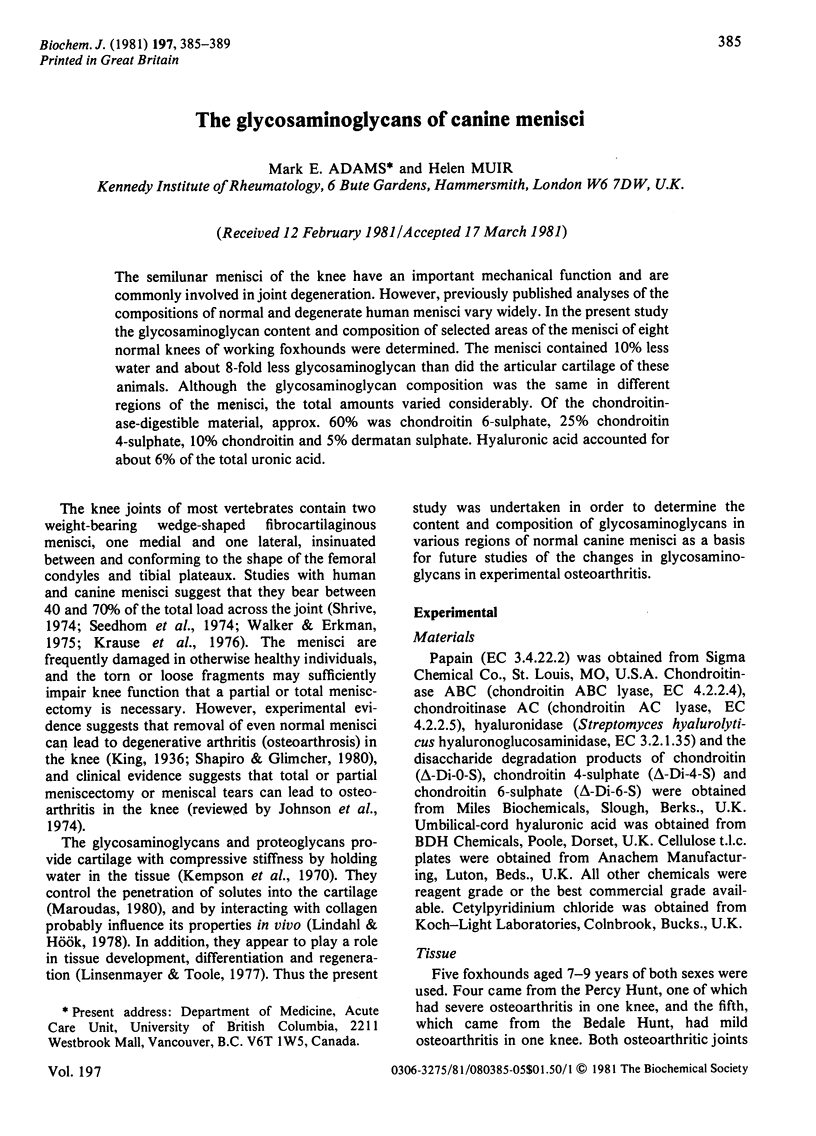
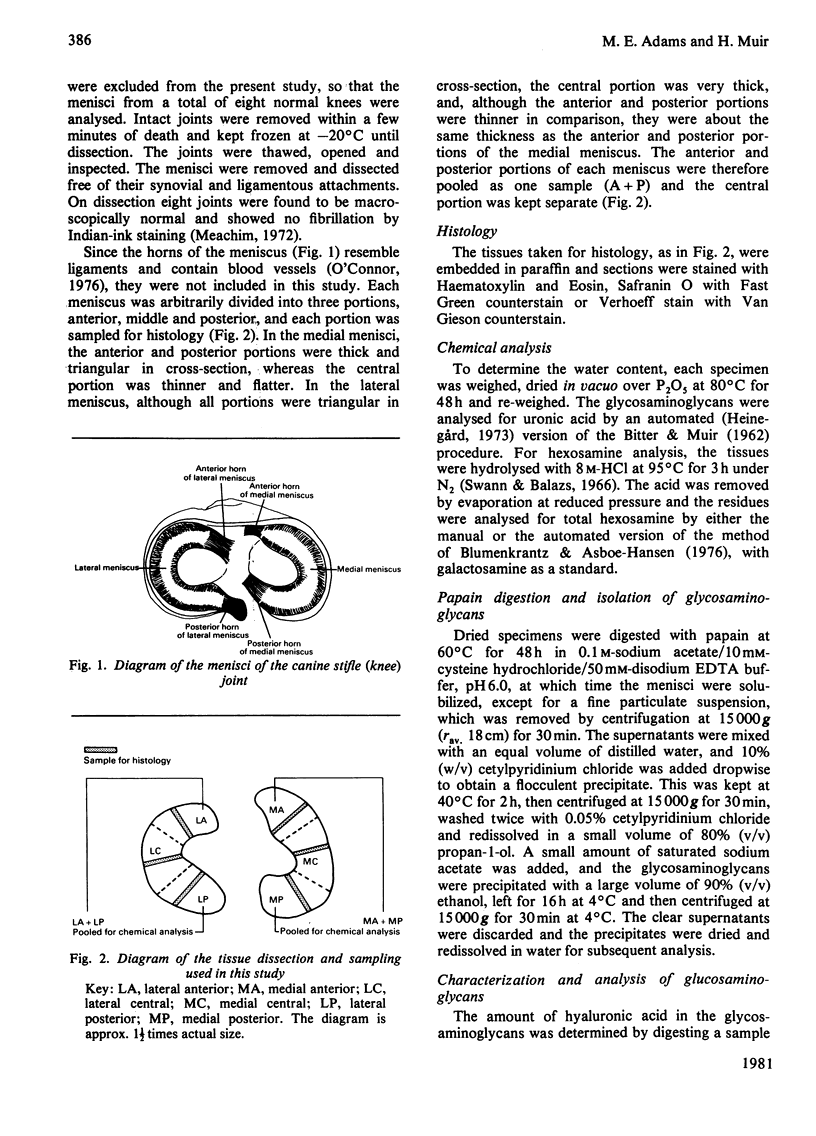
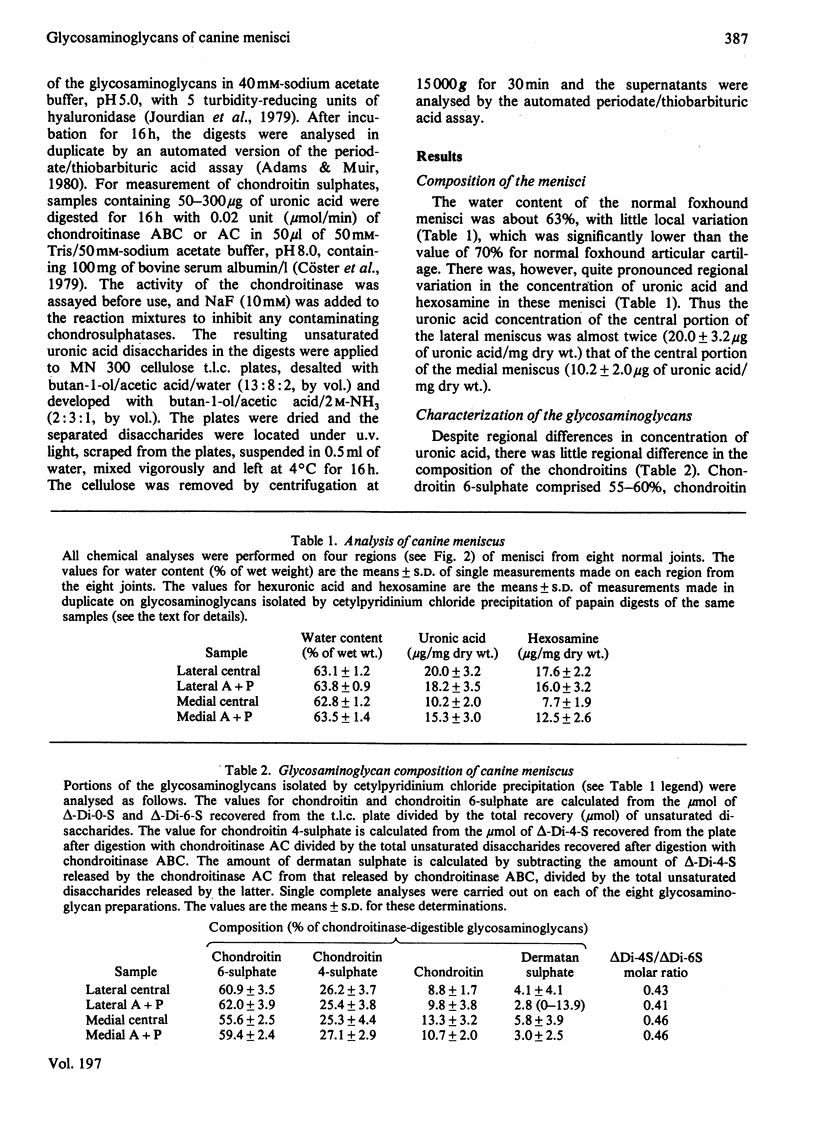
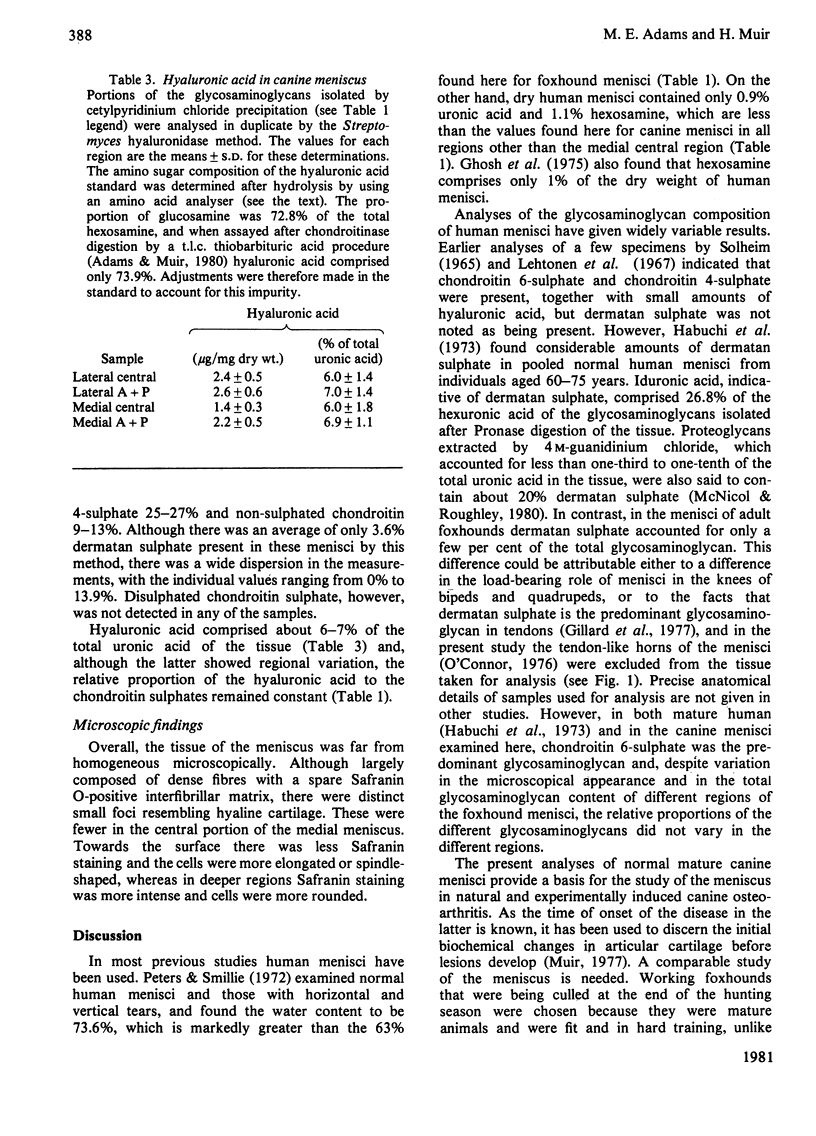
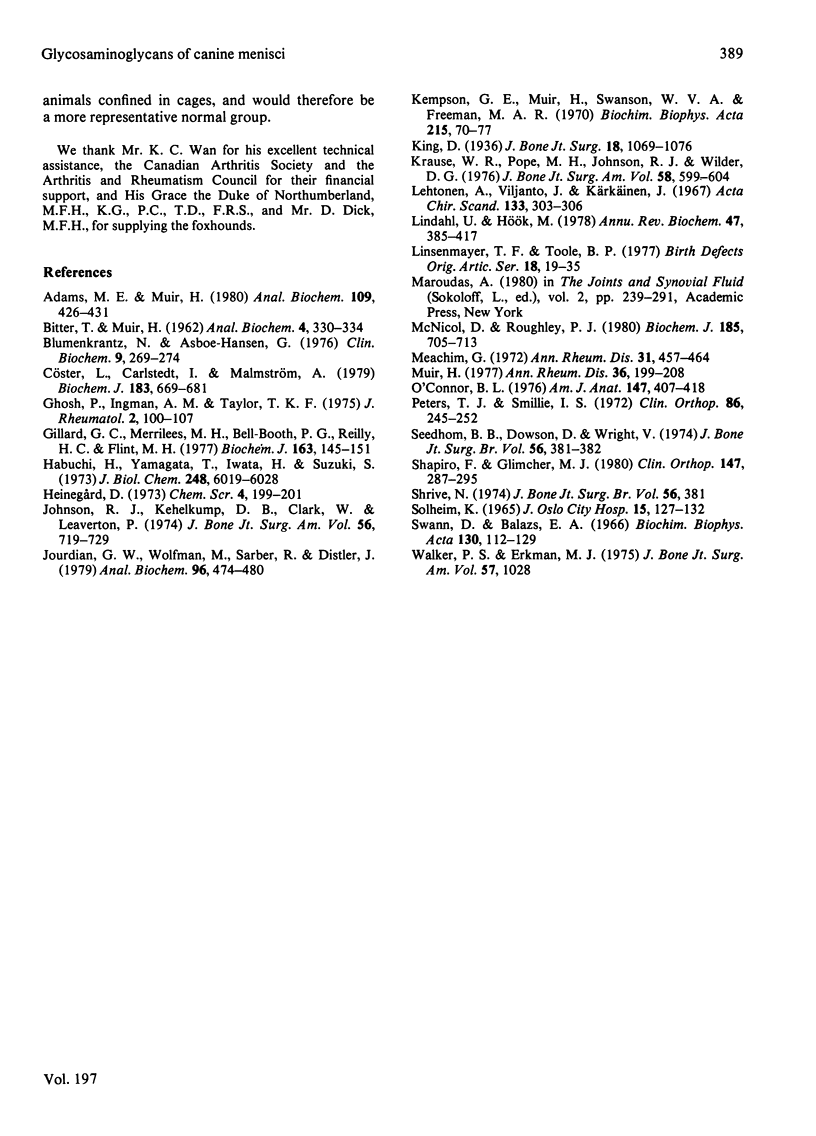
Selected References
These references are in PubMed. This may not be the complete list of references from this article.
- Adams M. E., Muir H. An automated version of the periodate-thiobarbituric acid assay for analysis of delta-4,5 unsaturated uronic acids and its application to the assay of hyaluronic acids and chondroitin sulfates. Anal Biochem. 1980 Dec;109(2):426–431. doi: 10.1016/0003-2697(80)90672-7. [DOI] [PubMed] [Google Scholar]
- BITTER T., MUIR H. M. A modified uronic acid carbazole reaction. Anal Biochem. 1962 Oct;4:330–334. doi: 10.1016/0003-2697(62)90095-7. [DOI] [PubMed] [Google Scholar]
- Blumenkrantz N., Asboe-Hansen G. An assay for total hexosamine and a differential assay for glucosamine and galactosamine. Clin Biochem. 1976 Dec;9(6):269–274. doi: 10.1016/s0009-9120(76)80075-6. [DOI] [PubMed] [Google Scholar]
- Cöster L., Carlstedt I., Malmström A. Isolation of 35S- and 3H-labelled proteoglycans from cultures of human embryonic skin fibroblasts. Biochem J. 1979 Dec 1;183(3):669–681. doi: 10.1042/bj1830669. [DOI] [PMC free article] [PubMed] [Google Scholar]
- Ghosh P., Ingman A. M., Taylor T. K. Variations in collagen, non-collagenous proteins, and hexosamine in menisci derived from osteoarthritic and rheumatoid arthritic knee joints. J Rheumatol. 1975 Mar;2(1):100–107. [PubMed] [Google Scholar]
- Gillard G. C., Merrilees M. J., Bell-Booth P. G., Reilly H. C., Flint M. H. The proteoglycan content and the axial periodicity of collagen in tendon. Biochem J. 1977 Apr 1;163(1):145–151. doi: 10.1042/bj1630145. [DOI] [PMC free article] [PubMed] [Google Scholar]
- Habuchi H., Yamagata T., Iwata H., Suzuki S. The occurrence of a wide variety of dermatan sulfate-chondroitin sulfate copolymers in fibrous cartilage. J Biol Chem. 1973 Sep 10;248(17):6019–6028. [PubMed] [Google Scholar]
- Johnson R. J., Kettelkamp D. B., Clark W., Leaverton P. Factors effecting late results after meniscectomy. J Bone Joint Surg Am. 1974 Jun;56(4):719–729. [PubMed] [Google Scholar]
- Jourdian G. W., Wolfman M., Sarber R., Distler J. A specific, sensitive method for the determination of hyaluronate. Anal Biochem. 1979 Jul 15;96(2):474–480. doi: 10.1016/0003-2697(79)90609-2. [DOI] [PubMed] [Google Scholar]
- Kempson G. E., Muir H., Swanson S. A., Freeman M. A. Correlations between stiffness and the chemical constituents of cartilage on the human femoral head. Biochim Biophys Acta. 1970 Jul 21;215(1):70–77. doi: 10.1016/0304-4165(70)90388-0. [DOI] [PubMed] [Google Scholar]
- Krause W. R., Pope M. H., Johnson R. J., Wilder D. G. Mechanical changes in the knee after meniscectomy. J Bone Joint Surg Am. 1976 Jul;58(5):599–604. [PubMed] [Google Scholar]
- Lehtonen A., Viljanto J., Kärkkäinen J. The mucopolysaccharides of herniated human intervertebral discs and semilunar cartilages. Acta Chir Scand. 1967;133(4):303–306. [PubMed] [Google Scholar]
- Lindahl U., Hök M. Glycosaminoglycans and their binding to biological macromolecules. Annu Rev Biochem. 1978;47:385–417. doi: 10.1146/annurev.bi.47.070178.002125. [DOI] [PubMed] [Google Scholar]
- Linsenmayer T. F., Toole B. P. Biosynthesis of different collagens and glycosaminoglycans during limb development. Birth Defects Orig Artic Ser. 1977;13(1):19–35. [PubMed] [Google Scholar]
- McNicol D., Roughley P. J. Extraction and characterization of proteoglycan from human meniscus. Biochem J. 1980 Mar 1;185(3):705–713. doi: 10.1042/bj1850705. [DOI] [PMC free article] [PubMed] [Google Scholar]
- Meachim G. Light microscopy of Indian ink preparations of fibrillated cartilage. Ann Rheum Dis. 1972 Nov;31(6):457–464. doi: 10.1136/ard.31.6.457. [DOI] [PMC free article] [PubMed] [Google Scholar]
- Muir H. Heberden Oration, 1976. Molecular approach to the understanding of osteoarthrosis. Ann Rheum Dis. 1977 Jun;36(3):199–208. doi: 10.1136/ard.36.3.199. [DOI] [PMC free article] [PubMed] [Google Scholar]
- O'Connor B. L. The histological structure of dog knee menisci with comments on its possible significance. Am J Anat. 1976 Dec;147(4):407–417. doi: 10.1002/aja.1001470402. [DOI] [PubMed] [Google Scholar]
- Peters T. J., Smillie I. S. Studies on the chemical composition of the menisci of the knee joint with special reference to the horizontal cleavage lesion. Clin Orthop Relat Res. 1972 Jul-Aug;86:245–252. doi: 10.1097/00003086-197207000-00037. [DOI] [PubMed] [Google Scholar]
- SOLHEIM K. THE GLYCOSAMINOGLYCANS OF HUMAN SEMILUNAR CARTILAGE. J Oslo City Hosp. 1965 Jun;15:127–132. [PubMed] [Google Scholar]
- Shapiro F., Glimcher M. J. Induction of osteoarthrosis in the rabbit knee joint. Clin Orthop Relat Res. 1980 Mar-Apr;(147):287–295. [PubMed] [Google Scholar]


